最新小学英语四大时态比较表
小学英语四大时态比较表知识分享

2.行为动词过去式
1.be going to +do
2.will /shall+do
一般疑问句
1.把动词be放于句首
2.用助动词do提问,如主语为第三人称单数,则用does,同时还原为动词原形。
把be动词放在句首。
1.把was或 were放于句首。
2.用助动词did提问,同时还原为动词原形。
动词原形
1.be放在句首。
2.will/shall提到句首。
否定句形式
1.be(am/is/are)+not
2.此时态的谓语动词若为行为动词,则在其前加don’t;若主语为第三人称单数,则用doesn’t,同时还原行为动词。
主语+am/ is/ are +not +doing
1.主语+was/were+ not
2. 在行为动词前加didn’t,同时还原行为动词。
1.be+not going to + do
2.will /shall+not+ do
动词
变化
1.主语非三单,动词用原形。
2.主语是三单,动词变三单形式:
1)大多数动词在词尾加“S”。
2)以辅音字母加“y”结尾的,要先将“y”变为“i”,然后在加“es”。
tomorrow,soon,
tomorrowmorning/afternoon,
the day after tomorrow ,
next Sunday/week/year/month,
结构
1.主语+be动词(am/is/are)+名词/形容词
2.主语+行为动词
主语+be(am/ is/ are )+doing
小学英语四种时态对比表.pdf

一般现在时一般过去式现在进行时一般将来时概念经常、反复发生的动作或行为及现在的某种状况。
用来叙述经常性发生的事情、习惯和爱好等。
一般过去时表示过去某个时间发生的动作或存在的状态,用在叙述某人正在做某事的时候。
(某动作正在进行)叙述将要发生的事情或打算。
表示将要发生的动作或存在的状态及打算、计划或准备做某事。
时间状语always, usually,often, sometimes,never, every week(day, year,month…), once aweek, on Sundays,ago, yesterday,the day beforeyesterday,in 1989, just now,at the age of 5,one day, longlong ago,now, at this time, thisweek, at thismoment,用look, listen提醒听者注意正在发生的事tomorrow, nextday(week, month,year…),soon, in afew minutes,by…,the day aftertomorrow,基本结构1)动词原形(如主语为第三人称单数,动词上要加(e)S)2)am/is/are+形容词/名词。
1)was/were+形容词/名字2)行为动词(动词过去式)am/is/are+doing1)am/is/are/going to+ do2)will + do否定式1) am/is/are+not。
2)谓语动词若为行为动词,则在其前加don't,如主语为第三人称单数,则用doesn't,同时还原行为动词1)was/were not2)didn’t +动词原形am/is/are+not+doing1)am/is/are/goingto+not+ do2)will + not; 在行为动词前加willnot,同时还原行为动词。
小学英语4种时态总结表

一
般 过 去
表示过去时间内发生的动作 或存在的状态
时
1、 yesterday, last week/ year/ month 等
2、 two years ago/ in 2005 / at that time 等
1、 动词 be 的过去时( were)
2、 行为动词的过去式
动词过去式: Be(was, were) 动词 +ed (talked)
时 态
定义
标志词
小学英语 4 种时态复习 谓语形式
一 1、 表示当前或现阶段事物
ቤተ መጻሕፍቲ ባይዱ
般
的状态、特征。
现 2、 表示经常性、习惯性、规
在
律性的动作。
时 3、 表示客观真理、客观存
在、客观事实。
频度副词: 例: always, usually, often,
sometimes, every day(month 、 week… .)
was,
1、 was / were 放主 语前
2、 主语前加 did (动 词还原 )
1、 was/ were +
not 2、 动 词 前 加
didn ’t (动词 还原 )
What did + 主 语 + do… ? 如 : Tom did his
homework last night.
What did Tom do last night?
be 放主语前
be + not
What is / are +主语 + doing ? 如 : We’re listening
now. What are you doing now?
(完整版)一般现在时、现在进行时、一般将来时、一般过去时四大时态讲解表格对比总结
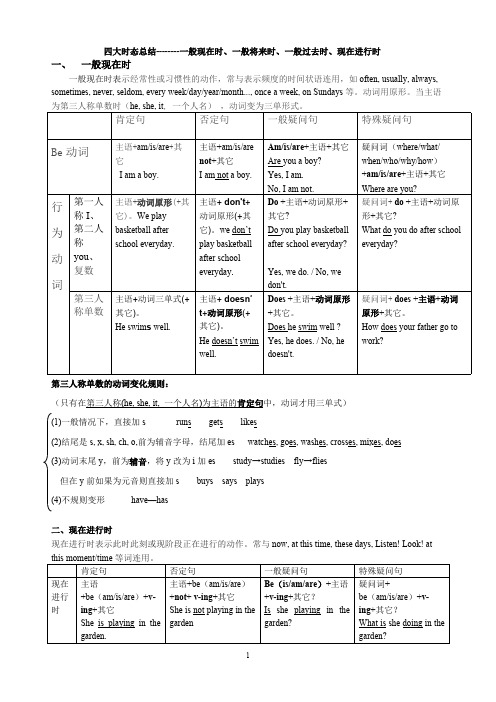
四大时态总结--------一般现在时、一般将来时、一般过去时、现在进行时一、一般现在时一般现在时表示经常性或习惯性的动作,常与表示频度的时间状语连用,如often, usually, always, sometimes, never, seldom, every week/day/year/month..., once a week, on Sundays等。
动词用原形。
当主语为第三人称单数时(he, she, it, 一个人名),动词变为三单形式。
肯定句否定句一般疑问句特殊疑问句Be动词主语+am/is/are+其它I am a boy.主语+am/is/arenot+其它I am not a boy.Am/is/are+主语+其它Are you a boy?Yes, I am.No, I am not.疑问词(where/what/when/who/why/how)+am/is/are+主语+其它Where are you?第一人称I、第二人称you、复数主语+动词原形(+其它)。
We playbasketball afterschool everyday.主语+ don't+动词原形(+其它)。
we don’tplay basketballafter schooleveryday.Do +主语+动词原形+其它?Do you play basketballafter school everyday?Yes, we do. / No, wedon't.疑问词+do +主语+动词原形+其它?What do you do after schooleveryday?行为动词第三人称单数主语+动词三单式(+其它)。
He swim s well.主语+ doesn’t+动词原形(+其它)。
He doesn’t swimwell.Does +主语+动词原形+其它。
Does he swim well ?Yes, he does. / No, hedoesn't.疑问词+ does +主语+动词原形+其它。
完整版)小学英语四大时态总结图
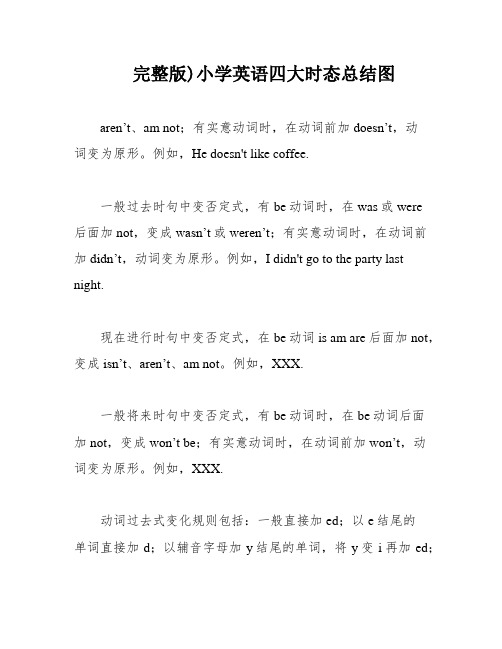
完整版)小学英语四大时态总结图aren’t、am not;有实意动词时,在动词前加doesn’t,动词变为原形。
例如,He doesn't like coffee.一般过去时句中变否定式,有be动词时,在was或were后面加not,变成wasn’t或weren’t;有实意动词时,在动词前加didn’t,动词变为原形。
例如,I didn't go to the party last night.现在进行时句中变否定式,在be动词is am are后面加not,变成isn’t、aren’t、am not。
例如,XXX.一般将来时句中变否定式,有be动词时,在be动词后面加not,变成won’t be;有实意动词时,在动词前加won’t,动词变为原形。
例如,XXX.动词过去式变化规则包括:一般直接加ed;以e结尾的单词直接加d;以辅音字母加y结尾的单词,将y变i再加ed;以辅元辅结尾的单词,双写最后一个辅音字母加ed;不规则变化。
例如,XXX.表示过去时间的词汇包括:yesterday、the day before yesterday、last + 时间(例如last year)、时间段+ago(例如one year ago)、in + 表示过去时间的词汇(例如in 1996)。
表示将来时间的词汇包括:now、tomorrow、the day after tomorrow、next + 时间段(例如next month)、in + 表示将来时间的词汇。
例如,We will go to the beach XXX.回答否定句时,需要注意人称及代词方面的变化。
有be 动词的句子中,将be动词提前,回答时用be动词回答;有实意动词时,需要助动词did的帮助,将did提前,回答时用did 回答。
最后,需要注意语态的变化。
例如,Active Voice句子:She ate the pizza。
小学英语4种时态总结表

小学英语4种时态总结表小学英语 4 种时态复习时态定义标志词谓语形式 1、系动词 be ( am, is, are) 行为动词原形 (主语为第三人称单数时 V + s, 或 es) 主语三人称单数主语非三单主语+动词三单形式She goes … 主语+ 动词原形I go … What is / are +主语+ doing? 如: We’re listening now. What are you doing now?1、 be 或 will 后加 not be 或 will 放主语前 be going to+动词原形 will+动词原形 1、动词 be 的过去时( was, were)2、行为动词的过去式动词过去式: Be(was, were) 动词+ed (talked) 不规则的动词过去式 came、saw 等) (went、 will not = won’t What is/ are +…going to do…? 2、 What will + 主语+do…? 如: He will play basketball ne_t week. What will he do ne_t week? 1、 be 放主语前 2、主语前加 do 或 does (动词还原) 疑问形式否定式提问谓语一般现在时1、表示当前或现阶段事物的状态、特征。
2、表示经常性、习惯性、规律性的动作。
3、表示客观真理、客观存在、客观事实。
频度副词:例:always, usually, often, sometimes, every day(month、week….)1、 be + not2、动词前加 don’t 或 doesn’t ( 动词还原)What do /does + 主语+ do…? 如:She reads English every day. What does she do every day?现在进行时1 、表示说话的此时此刻正在进行的动作或存在的状态。
(完整版)小学英语四大时态表格版
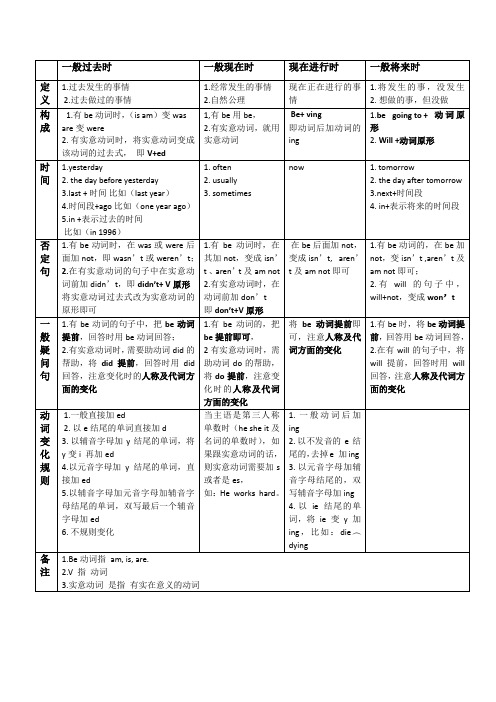
备注
1.Be动词指am, is, are.
2.V指动词
3.实意动词是指有实在意义的动词
5.以辅音字母加元音字母加辅音字母结尾的单词,双写最后一个辅音字母加ed
6.不规则变化
当主语是第三人称单数时(he she it及名词的单数时),如果跟实意动词的话,则实意动词需要加s或者是es,
如:He workshard。
1.一般动词后加ing
2.以不发音的e结尾的,去掉e加ing
3.以元音字母加辅音字母结尾的,双写辅音字母加ing
比如(in ly
3.sometimes
now
1.tomorrow
2.the day after tomorrow
3.next+时间段
4.in+表示将来的时间段
否定句
1.有be动词时,在was或were后面加not,即wasn’t或weren’t;
2.在有实意动词的句子中在实意动词前加didn’t,即didn’t+ V原形
一般过去时
一般现在时
现在进行时
一般将来时
定义
1.过去发生的事情
2.过去做过的事情
1.经常发生的事情
2.自然公理
现在正在进行的事情
1.将发生的事,没发生2.想做的事,但没做
构成
1.有be动词时,(isam)变was
are变were
2.有实意动词时,将实意动词变成该动词的过去式,即V+ed
1,有be用be,
2.有实意动词,就用实意动词
Be+ ving
即动词后加动词的ing
1.begoing to+动词原形
最新小学英语4种时态总结表
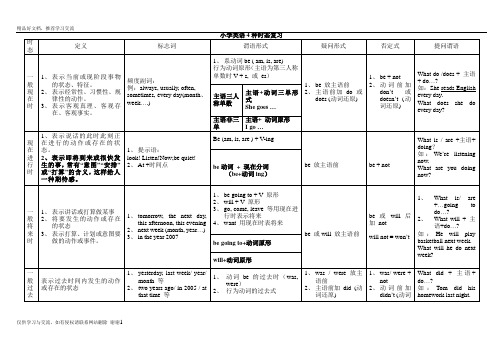
小学英语4种时态复习
1
2 2019年两会热点内容
增速目标小幅下调至6-6.5%,政策宽松持续
政府将2019年GDP增速目标从2018年的6.5%左右下调至6-6.5%。
政府工作报告指出当前经济下行压力加大,强调要发挥好宏观政策逆周期调解作用来稳增长、防风险、创造新增就业。
我们维持2019年GDP增长6.1%的预测不变,若如果中美达成广泛的框架性贸易协议,经济增速可能会达到6.2-6.3%。
扩大减税降费规模,利好企业盈利、提振市场情绪
政府计划今年减税降费近2万亿(相当于2%的GDP),大部分是针对企业部门减税减费。
制造业增值税率将降低3个百分点至13%,企业养老保险单位缴费率可降低至16%(相对标准费率下降3-4个百分点),这可以有助于改善企业资产负债表、并利好消费者(如果减税后企业降低产品价格),但对企业资本开支和整体GDP增长的拉动作用可能比较有限。
扩大显性财政赤字
3。
英语四大时态表格
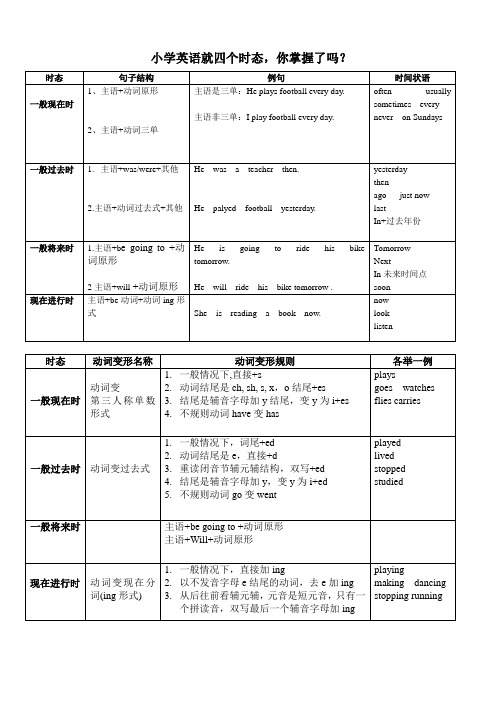
1.主语+was/were+其他
2.主语+动词过去式+其他
He was a teacher then.
He palyed football yesterday.
yesterday
then
ago just now
last
In+过去年份
一般将来时
1.主语+be going to +动词原形
2主语+will+动词原形
2.以不发音字母e结尾的动词,去e加ing
3.从后往前看辅元辅,元音是短元音,只有一个拼读音,双写最后一个辅音字母加ing
playing
making dancing
stopping running
动词变形名称
动词变形规则
各举一例
一般现在时
动词变
第三人称单数形式
1.一般情况下,直接+s
2.动词结尾是ch, sh, s, x,o结尾+es
3.结尾是辅音字母加y结尾,变y为i+es
4.不规则动词have变has
ays
goes watches
flies carries
一般过去时
动词变过去式
1.一般情况下,词尾+ed
2.动词结尾是e,直接+d
3.重读闭音节辅元辅结构,双写+ed
4.结尾是辅音字母加y,变y为i+ed
5.不规则动词go变went
played
lived
stopped
studied
一般将来时
主语+be going to +动词原形
主语+Will+动词原形
(完整版)小学英语四大时态总结图

有be动词的句子中,把be动词提前即可,回答时用be动词回答;有实意动词时,需要助动词did的帮助,将did提前即可,回答时用did回答,注意变化时的人称及代词方面的变化
有be动词的句子中,把be动词提前即可,回答时用be动词回答;有实意动词时,需要助动词do的帮助,将do提前即可,回答时用do回答,注意变化时的人称及代词方面的变化
5in +表示过去的时间比如(in 1996)
1of
now
1tomorrow
2the day after tomorrow
3next+时间段比如(next month)
4in+表示将来的时间段
否定句
一般过去时中变否定句,有be动词时,在was或were后面加not,变成wasn’t或者weren’t;在有实意动词的句子中在实意动词前加didn’t,将实意动词过去式改为实意动词的原形即可
将be动词提前即可,注意人称及代词方面的变化
在有be动词的句子中,将be动词提前,回答时用be动词回答,在有will的句子中,将will提前,回答时用will回答,注意人称及代词方面的变化
备注
动词过去式变化规则:
1一般直接加ed
2以e结尾的单词直接加d
3以辅音字母加y结尾的单词,将y变i再加ed
4以辅元辅结尾的单词,双写最后一个辅音字母加ed
一般现在时句中变否定式,有be动词时,在is am are后面加not,变成isn’t aren’t及am not即可;有实意动词的句子,在实意动词前加don’t即可
在is am are后面加not,变成isn’t aren’t及am not即可
在有be动词的句子中,在be动词is am are后面加not,变成isn’t aren’t及am not即可;在有will的句子中,在will后面加not,变成won’t即可
小学英语时态总结表格
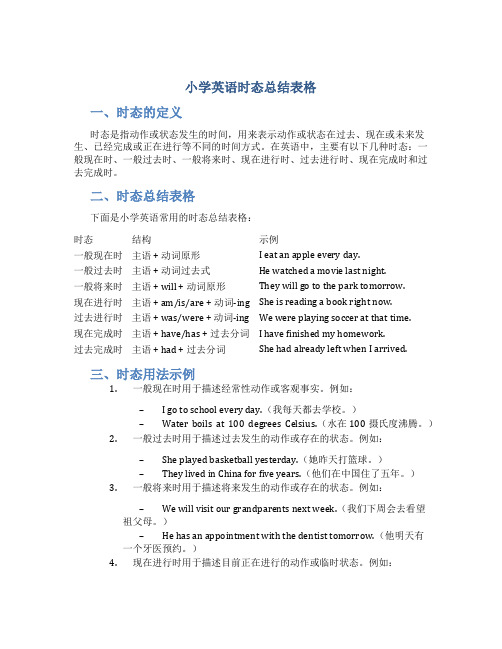
小学英语时态总结表格一、时态的定义时态是指动作或状态发生的时间,用来表示动作或状态在过去、现在或未来发生、已经完成或正在进行等不同的时间方式。
在英语中,主要有以下几种时态:一般现在时、一般过去时、一般将来时、现在进行时、过去进行时、现在完成时和过去完成时。
二、时态总结表格下面是小学英语常用的时态总结表格:时态结构示例一般现在时主语 + 动词原形I eat an apple every day.一般过去时主语 + 动词过去式He watched a movie last night.一般将来时主语 + will + 动词原形They will go to the park tomorrow.现在进行时主语 + am/is/are + 动词-ing She is reading a book right now.过去进行时主语 + was/were + 动词-ing We were playing soccer at that time.现在完成时主语 + have/has + 过去分词I have finished my homework.过去完成时主语 + had + 过去分词She had already left when I arrived.三、时态用法示例1.一般现在时用于描述经常性动作或客观事实。
例如:–I go to school every day.(我每天都去学校。
)–Water boils at 100 degrees Celsius.(水在100摄氏度沸腾。
)2.一般过去时用于描述过去发生的动作或存在的状态。
例如:–She played basketball yesterday.(她昨天打篮球。
)–They lived in China for five years.(他们在中国住了五年。
)3.一般将来时用于描述将来发生的动作或存在的状态。
例如:–We will visit our grandparents next week.(我们下周会去看望祖父母。
完整版小学英语四大时态总结

小学英语四大时态总结小学英语四大时态总结一.一般现在时:1. 一般现在时的简单用法:表示经常的,习惯性的动作或存在的状态。
一般现在时经常与often,always,usually,sometimes,every day等时间状语连用。
否定句:主语+ be + not +其它。
如:He is not a worker.他不是工人。
一般疑问句:Be +主语+其它。
如:-Are you a student? -Yes. I am. / No, I'm not. 特殊疑问句:疑问词+一般疑问句。
如:Where is my bike? 5. 行为动词的变化。
否定句:主语+ don't( doesn't ) +动词原形(+其它)。
如:I don't like bread. 当主语为第三人称单数时,要用doesn't构成否定句。
如:He doesn't often play. 一般疑问句:Do( Does ) +主语+动词原形+其它。
如:- Do you often play football? - Yes, I do. / No, I don't. 当主语为第三人称单数时,要用does 构成一般疑问句。
如:- Does she go to work by bike? - Yes, she does. / No, shedoesn't. 特殊疑问句:疑问词+一般疑问句。
如:How does your father go to work? 二.现在进行时:1.现在进行时:表示现在正在进行或发生的动作,也表示当前一段时间内的活动或现阶段正在进行的动作。
2.结构:be ( am, is, are )+doing (所有的动词+ing)3.ing 的变化规则:2).现在进行时的一般疑问句把be动词调到句首。
Is he working at home? 3).现在进行时的特殊疑问的基本结构为:特殊疑问词+ be + 主语+ 动词ing? What are you doing? 三.一般过去时:Page 1 of 6.I. 一般过去时的概念:表示过去某个时间发生的动作或存在的状态。
小学英语4种时态表格

小学英语语法之时态谓语动词构造变化表当我们说时态构造的时候,指的是相应时态下的动词形式,也就是说时态表此刻谓语动词的不一样形式变化上。
下表简单说了然各个时态谓语动词的不一样构造变化:(注:表中do 代表动词)时态时态定义谓语动词变化时间状语标记现① 表示说话的此时此刻正在进行的动作在或事情。
be 动词 + 此刻分词Now、 Look ,、 Listen, 进② 表示马上到来或很快发生的事,常有( be+动词 ing )行“企图”“安排”或“打算”的含义,时这样给人一种期望感。
一主语三人称主语 +动词三单形式① 表示目前或现阶段事物的状态、特点。
般单数She goes② 表示常常性、习惯性、规律性的动作。
often 、 sometimes 、 usually 、 always 、现③ 表示客观真谛、客观存在、客观事实。
主语 + 动词原形every day ( months 、 years )在主语非三单I go时一① 表示过去某一时间发生的动作、事件。
动词过去式:动词 +ed (talked) this morning 、 yesterday 、long ago 、 last般过去时一般①表示打算、计划或企图要做的动作或事将件。
来时不规则的动词过去式(went)be going to+动词原形will+ 动词原形year 、 last week、last monthtomorrow 、 next week 、next month、next year一.第三人称单数形式的组成一般此刻时第三人人称单数时,谓语动词后加-s 或 -es ,与名词复数变化大概同样。
1. 在动词后加。
如:work–works2.以 s, x, sh, ch结尾,后加-es。
如:teach - teaches3. 以辅音字母加y 结尾,改 y 为 i ,加 es。
如: study - studies4. 不规则变化。
如 have - has。
(完整版)小学英语四种时态的比较

Class: Name:( )1. Good morning! !A.Morning !B.Hello !C.Hi !( )2. Nice to see you again ! .A.How are you ?B.Nice to see you , too .C.How do you do ? ( )3.Good night,mom !A.Night !B.Good night !C.Good evening .( )4.How do you do ?A.How are you ?B.Fine,thanks .C.How do you do ?( )5.How many story books do you have ?A.I have 10.B.I can see 10.C.Thirty yuan.( )6.Do you have new teachers?A.Yes,we do .B.Yes,we don’t.C.Yes,we have .( )7.Who’s your art teacher ?A.Mr Zhu.B.Miss Zhu.C.He’s tall.( )8.What’s he like?A.He’s tall and strong .B.Yes,he is.C.Mr Zhu.( )9.Is your English teacher young?A.No,she isn’t.B.Yes,she is .C.No,she is.( )10. ? Her name is Chen Jie.A.What’s your name ?B.What’s she name ?C.What’s her name ?( )11. ? I like Chinese,math and English. A.What classes do you like? B.What do you like? C.What are you like ?( )12. ? We have English and P.E.A.What do you have on Mondays ?B.What do you have ?C.What do you have on Monday?( )13. ? It’s Monday.A.What is it today ?B.What day is it today ?C.What day is today ?( )14. ? I watch TV and do my homework.A.What do you do ?B.What do you do in Mondays?C.What do you do on Sundays ?( )15.May I have a look ?A.Sure.Here you are .B.Look !C.Here you are .( )16.Our math teacher is Canada.A.fromB.inC.at( )17.I three new teachers.A.hasB.amC.have( )18.What’s Chinese teacher like ?A.youB.yourC.you’re( )19.My P.E.teacher is thin.A.tooB.soC.very( )20.There are days in a week.A.sixB.sevenC.eight( )21.There are month(月)in a year(年).A.tenB.elevenC.twelve( )22.I often watch TV Saturday .A.onB.inC.at( )23.I like P.E. I don’t lime music.A.butB.andC.so( )24.This is apple. It is red apple.A.a , aB.an,anC.an, a( )25.What do you like ?A.classesB.classC.class’s六年级英语测试题Class: Name:( )1. How are you ?A.Fine,thanks.B.Yes,it is.C.How are you ?( )2. Nice to meet you !A.Fine,thank you.B.OK.C.Nice to meet you ,too !( )3. How do you go to school ?A.I go to Canada by plane.B.I go to school by bike.C.What about you ?( )4. How do you go to the USA ?A.I usually go to school by bus.B.I go to England by ship.C.I go by plane.( )5. ? My home is near the post office.A. Where is your home ?B.OK.C.See you then!( )6. See you at 2 o’clock.A.See you then !B.The fifth floor.C.It’s easy.( )7. ? You can go by the No.15 bus.A.It’s not far.B. How can I get to Zhongshan Park ?C.Sure.( )8. Where is the hospital?A.Next to the cinema.B.Thank you .C.You’re welcome.( )9. Excuse me ,is there a cinema near here ?A.Yes,there is .B.No,it’s not far.C.It’s near the post office.( )10.? ? It’s near the post office.A.Yes,there is .B.No,it’s not far.C. Where is the library?( )11. ? It’s next to the hospital.A. Where is the cinema ,please ?B.Is it far ?C.Go straight.( )12. How can I get to the hospital ?A.It’s next to the hospital.B.You can go by the No.201 bus.C.Thank you.( )13.Thank you .A.Thank you .B.OK.C.You’re welcome.( )14. How can I get to the museum?A.Go straight.Then turn left.B.Thank you .C.It’s east of the cinema .( )15. Where is the post office ?A.Go straight.Then turn left.B.Thank you .C.It’s east of the cinema .( )16. What are you going to do this evening ?A.I’m going to the cinema .B.I go to school on foot.C.Yes,it is.( )17. Is it far ?A.No,it is .B.Yes , it is .C.Yes,it isn’t. ( )18. do you go to school ?A.WhatB.WhereC.How( )19. I go to school bike.A.onB. byC.get( )20. Can I go foot ?A.byB.atC.on( )21.How can I to the post office ?A.nearB. getC.for( )22. me.A. ExcuseB. HowC.next( )23. birthday to you !A. AfterB.HappyC.First( )24. The hospital is the left.A. atB.inC.on( )25. is the bookstore ?A.WhereB.HowC.When四年级英语测试题Class: Name:( )1.Good afternoon !A.Hello!B.Hi !C.Afternoon !( )2.Nice to see you again !A.How are you ?B.Hello !C.Nice to see you , too.( )3.Good night,moom !A.Good evening !B.Good night !C.Night !( )4.How are you ?A.Fine,thank you .B.I am 10.C.Nine .( )5.How do you do ?A.Fine ,Thank you .B.How are you ?C.How do you do ?( )6.How old are you ?A.How are you ?B.I am 11.C.I have 11.( )7. ? I have 23.A.How many books do you have ?B.How many books can you see?C.How many book do you have ?( )8. ? I can see 6.A.How many lights do you have ?B.How many lights can you see ?C.How many light can you see ?( )9.May I have a look ?A.Sure.Here you are .B.Look!C.Sure.Here are you .( )10. ? 50 yuan.A.How much is this schoolbag ?B.How many is this schoolbag ?C.How much are this schoolbag ?( )11.Where’s my seat ?A.It’s near the door.B.It’s on the door.C.It’s under the door. ( )12.Let’s clean the desks and chairs.A.All right !B.Hello !C.It’s nice .( )13.What’s this ?A.There is a board .B.It’s a bee.C.It’s bee.( )14. ? My name is Mike.A.Here are you ?B.What’s your name ?C.How do you do ? ( )15.Who’s the inventor of paper ?A.Chinese people.B.Oh! Great !C.Hello!( )16.I a student. You a teacher.A.am ,amB.are, areC.am, are( )17.This a boy.His name Zhang Peng.A.is, isB.am , isC.is , are( )18.Let clean the fish bowl.A.IB. meC.my( )19.This is apple.It is red apple .A.an ,anB.a, aC.an, a( )20.We a new classroom.A.areB.haveC.has( )21.There a bee in our classroom.A. isB.areC.am( )22. have a new schoolbag. schoolbag is heavy.A.I , myB.I ,MyC.My , I( )23.Put your English book your head.A.atB.inC.on( )24.There many books in the desk.A.amB.isC.are( )25.How many do you have ? A.pencil B.pencils C.pencils. 三年级英语测试题Class: Name:( )1.当向别人打招呼时,应该说:A.Hello.B.Good morning .( )2.How are you ? 的正确答语是:B.I’m fine,thank you .( )3.当想知道别人的名字时,应该说:A.What’s your name ?B.See you.( )4.字母K的小写是:A.kB.( )5.Nice to meet you 的意思是:A.见到你很高兴。
小学英语4种时态总结表
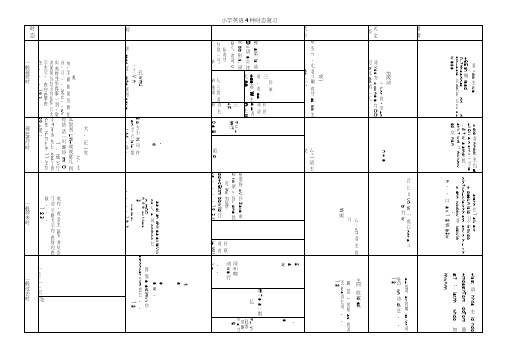
h、 、 口a v 1 2 W b3w
形 原 词 动|+Wil
一般过去时
.一AZVJ/一、示
“t
a
e
e w ・
等 等e erclmyy亦estonwat yym他也 、 、1 2
5
a
w
词⑹咖
动we行
、 、
1 2
主同 放id ed'
W加} / 前原as前语还wa语主词 、 、
1 2
e+加词er前側as/ot词卅切wn动di还 、 、
1 2
+isst语hhtla主id.ndo +mdastnTom ddTom器at? : lathh whdo如hhwhnn
\!7e a: 街亿
念
、
e
IT-X)砒等 加W动a勺S
n+e
+ glg语nnool主怕d+IISU e o arr'y/肘re •£ ? w a atng:肌at/v? woi口owwow sd女nsn
诟g
一般将来时
或的、或 话生 算作 讲发态打动 示要伏示的 表将的表做 、 、 、
1 2 3
aa.gj an dnir ea exteVyy ns入e训onthoo也n,m00
小学英语4种时态复习
时 态
标
式 形
式 定 否
语 谓
一般现在时
规
物、存 蓼 准 观 段 惯 客 阶。习 、。 现征、。w>实 或特性作真事 〉刖、常动观观 当态经的客客 示伏示性示、 表的表律表在 、 、 、12 3
孔wmJ
、!Vn
副aees度:m2e频例sswe
称a第is讪❾g语e((住或bb形s,词原八 动词V系动时
- 1、下载文档前请自行甄别文档内容的完整性,平台不提供额外的编辑、内容补充、找答案等附加服务。
- 2、"仅部分预览"的文档,不可在线预览部分如存在完整性等问题,可反馈申请退款(可完整预览的文档不适用该条件!)。
- 3、如文档侵犯您的权益,请联系客服反馈,我们会尽快为您处理(人工客服工作时间:9:00-18:30)。
2.行为动词过去式
1.be going to +do
2.will /shall+do
一般疑问句
1.把动词be放于句首
2.用助动词do提问,如主语为第三人称单数,则用does,同时还原为动词原形。
把be动词放在句首。
1.把was或 were放于句首。
2.用助动词did提问,同时还原为动词原形。
小学英语四大时态比较
1、一般现在时
2、现在进行时
3、一般过去时
4、一般将来时
定义
经常、反复发生的动作或行为及现在的某种状况。
表示现阶段或说话时正在进行的动作或状态。
过去某个时间里发生的动作或状态; 过去 习惯性、经常性的动作、行为。
表示将要发生的动作或存在的状态及打算、计划或准备做某事。
时间状语
often, usually, always, sometimes,
2. 在行为动词前加didn’t,同时还原行为动词。
1.be+not going to + do
2.will /shall+not+ do
动词
变化
1.主语非三单,动词用原形。
2.主语是三单,动词变三单形式:
1)大多数动词在词尾加“S”。
2)以辅音字母加“y”结尾的,要先将“y”变为“i”,然后在加“es”。
tomorrowBiblioteka soon,tomorrowmorning/afternoon,
the day after tomorrow ,
next Sunday/week/year/month,
结构
1.主语+be动词(am/is/are)+名词/形容词
2.主语+行为动词
主语+be(am/ is/ are )+doing
4.以ie结尾的动词
动词变过去式:
1. 在原次末尾加ed 或d
2. 辅音加y 结尾去y加ied
3. 辅音元音辅音结尾双写最后一个字母加ed
4.特殊变化:can-coulddo-did eat-ate go-wentsit-satcome-came get-gothave-had see-saw begin-began give-gave win-won read-read
1.be放在句首。
2.will/shall提到句首。
否定句形式
1.be(am/is/are)+not
2.此时态的谓语动词若为行为动词,则在其前加don’t;若主语为第三人称单数,则用doesn’t,同时还原行为动词。
主语+am/ is/ are +not +doing
1.主语+was/were+ not
every day(week,month),
once a week, on Mondays,
now, at this time,
these days,
ago, yesterday,
last week(month, year…), in 2000, just now, one day, long long ago
3)以“s, x, ch, sh,o ”结尾的,在词尾加“es”。
4)不规则动词have-has。
动词变现在分词:
1.一般情况下,加ing,如:play- playing
2.以不发音字母e结尾的动词,去e加ing,
如:ride – riding
3.重读闭音节辅元辅结构,双写末尾辅音字母加ing,如:swim-swimming
动词原形
一、技术资料阐述
二、 仪器仪表、车辆及工机具管理
三、 备品、备件、维护材料管理
四、 请示报告制度
光缆线路割接管理办法
维护质量保障体系
安全管理
五、 人员、车辆及仪器仪表配置
